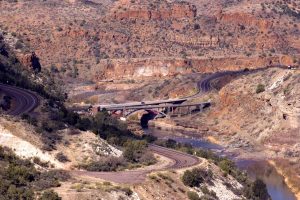What Are the Most Dangerous Roads in Arizona
 We know we’re a bit biased, but we think driving through Arizona is pretty extraordinary. There are some truly gorgeous scenic drives in our state, and every year, visitors come from all over the world to view them.
We know we’re a bit biased, but we think driving through Arizona is pretty extraordinary. There are some truly gorgeous scenic drives in our state, and every year, visitors come from all over the world to view them.
But all that traffic, along with daily commutes, commercial transport, and unpredictable weather means some of our rods are the most dangerous in the country. According to Freight Waves, US Route 93 is a part of that list. This highway stretches for 200 miles all the way from Las Vegas to Phoenix. Sadly, its reputation for frequent traffic accidents is just as well-known as its most beloved sightseeing attraction, the Mike O’Callaghan-Pat Tillman Memorial Bridge. Over a six-year time span, there were 70 fatal crashes that occurred on this roadway, resulting in the deaths of 90 people. Unfortunately, US Route 93 is not in a league of its own.
Other dangerous highways and roads include:
Even though Arizona should not be singled out as a state with the most dangerous roads, fatal traffic accidents tend to be a common occurrence. Even during a global pandemic, the number of fatal crashes remained the same.
What is it about the roads that lead to fatal accidents? The conditions of the roads? The drivers? As it turns out, it may be a combination of both.
Speeding plays a major role in making roads dangerous
While drivers can travel faster because of higher speed limits on US 93 and I-17, drivers are also putting themselves at risk by reducing their reaction times. The higher the speed, the less amount of time a driver has to react to changes in road conditions. The impact and possible injury of a crash progressively increase as a driver’s speed increases as well. This is definitely the case for US Route 93, as excessive speeding is believed to be one of the leading causes of the 90 fatalities.
Aggressive driving can occur anywhere
Another dangerous behavior that many drivers have engaged in is aggressive driving. The National Highway Traffic and Safety Administration (NHTSA) defines aggressive driving as a combination of moving traffic offenses committed by an individual that endangers other persons or property. In addition to speeding, aggressive driving was determined as the leading factor in 56% of fatal traffic accidents. Examples of aggressive driving include following improperly behind a vehicle, erratic lane changing, driving illegally on a road shoulder, failing to yield the right of way, failing to signal, and making an improper turn.
One reason many drivers engage in aggressive driving is due to road rage. Sadly, road rage is not a rare phenomenon. Over the span of seven years, there have been 200 murders and 12,000 injuries that are linked back to road rage. In 2019, 82% of drivers admitted to engaging in acts of road rage. Everyone has had their patience tested while driving a time or two. It’s not okay, however, to engage in behaviors that can injure yourself or the drivers around you.
Does distracted driving contribute to making roads dangerous?
Yes, it does – especially when drivers think they don’t need to give a road their full attention. When a driver is engaging in anything that takes their focus off of the road, the driver is engaging in distracted driving. If you are daydreaming while driving, that can be considered distracted driving. If you’re eating or drinking something while driving, that is an example of distracted driving. Even an action as understandable as checking on one’s children while driving can be considered a form of distracted driving.
According to the NHTSA, 3,142 people died in 2019 because of distracted driving, and as many as 424,000 were injured. If something needs to be addressed immediately, it is better to pull over on the side of the road and tend to it than to try to multitask while driving. The conditions of the road can change in a second, and a driver’s divided attention can be the deciding factor in whether a fatal accident occurs or not.
Why is tailgating so dangerous?
Another dangerous behavior that drivers engage in is following a vehicle too closely, or the form of driving known as tailgating. Tailgating can result in a severe traffic accident for several reasons. One of the main reasons is the possibility of an immediate rear-end collision. If a driver in front of you decides to immediately stop for whatever reason, you do not have enough time to react in a safe manner. You may find yourself immediately slamming down on brakes and being ejected from your vehicle.
Dangerous road designs can cause blind spots
Blindspot accidents can be fatal when the driver of a larger vehicle, like a commercial truck, fails to check their blind spots. But sometimes, the road’s actual design can increase blind spots and decrease visibility. Salt River Canyon is a winding, two-lane highway that can leave drivers frustrated and blind when they’re stuck behind 18-wheelers.
Were you injured in a car accident on one of Arizona’s dangerous roads? You can protect your rights by consulting with an experienced Phoenix car crash attorney at Plattner Verderame. Call our office at 602-266-2002 or complete the contact form to schedule a free consultation at one of our offices in Phoenix or Tempe.
What, Where, When, Why – Car Accident Frequently Asked Questions

Attorney Richard Plattner has been active in leadership in the Arizona Association for Justice (lawyers who represent injured folks, and formerly known as the Arizona Trial Lawyers Association) since 1985 and served as President in 1991. If you have been the victim of a personal injury, contact Plattner Verderame today.
Read more about Richard Plattner.
